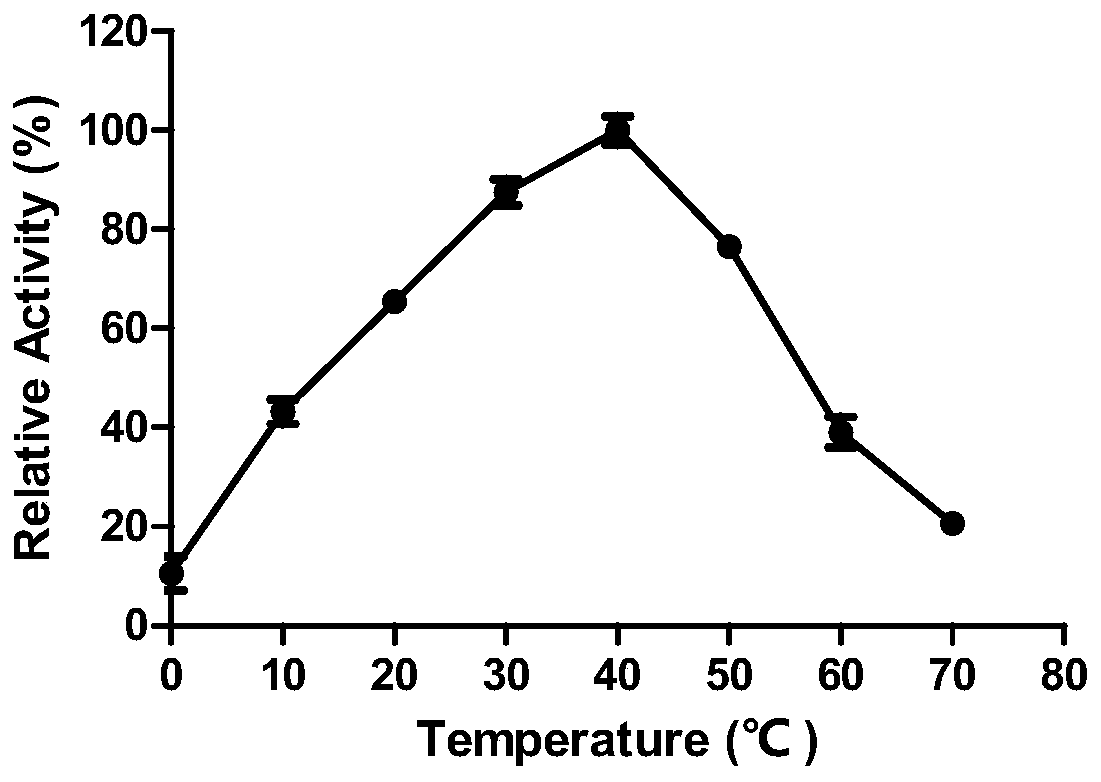L-carrageenan enzyme with thermal stability and application thereof
A carrageenase and carrageenan technology, applied in the biological field, can solve the problems of inability to achieve industrial application, poor thermal stability and thermal recovery of ι-carrageenase, easy inactivation, etc., and achieve good industrial application prospects and excellent physical and chemical properties. , The effect of purification method is simple
- Summary
- Abstract
- Description
- Claims
- Application Information
AI Technical Summary
Problems solved by technology
Method used
Image
Examples
Embodiment 1
[0031] Embodiment 1 ι-carrageenase CgiV sequence analysis
[0032]The enzyme-producing gene CgiV of the iota-carrageenase CgiV of the present invention is derived from the marine bacterium Vibrio sp.SY01, and the strain is preserved in the China Center for Type Culture Collection with the preservation number CCTCC No: M2018769. Contains 1359 base sequences, encoding 452 amino acid sequences. Using the conserved domain analysis of the National Center for Biotechnology Information (NCBI) to analyze the Conserved domain (CDD) and the multiple sequence alignment Basic Local AlignmentSearch Tool (Blast), it was found that the sequence contained a conserved region of the polysaccharide hydrolase (GH 82) family . Among the reported ι-carrageenases, the one with the highest amino acid sequence similarity to CgiV is the ι-carrageenase (Genbank APX55175) from the GH82 family of Flavobacterium sp., the amino acid sequence similarity between the two (Identity) was 88%.
Embodiment 2
[0033] Recombinant expression of embodiment 2-carrageenase CgiV
[0034] The iota-carrageenase CgiV gene sequence in Example 1 uses restriction endonucleases Nco I and Xho I as the enzyme cutting sites, and the recombinant primers are designed as follows (the underline is the restriction endonuclease site, and the italic is the restriction endonuclease site. Dicer protected bases):
[0035] Forward primer: SEQ ID NO.3: PCgiVF:
[0036] 5'-CATG CCATGG ATGATTAAAGCATCTGATTTC-3' (Nco I)
[0037] Reverse primer: SEQ ID NO.4: PCgiVR:
[0038] 5'-CCG CTCGAG TTTACCTTGTTTACAGTTTTTAC-3' (Xho I)
[0039] PCR amplification conditions were: pre-denaturation at 94°C for 3 minutes; denaturation at 94°C for 30 seconds, annealing at 55°C for 30 seconds, extension at 72°C for 1.5 minutes, a total of 30 cycles; extension at 72°C for 5 minutes; stabilization at 4°C for 15 minutes. The DNA polymerase used in the PCR reaction was PrimerstarHS purchased from Dalian Bao Biological Company.
...
Embodiment 3
[0042] Fermentation and purification preparation method of embodiment 3-carrageenase CgiV
[0043] The Escherichia coli BL21(DE3) / pET22b-CgiV constructed in Example 2 was transferred to LB liquid medium (50 μg / mL ampicillin), and cultured in a shaker at 37°C at 180rpm to OD 600 = 0.6. Add the inducer isopropyl-β-D-thiogalactopyranoside (IPTG) at a final concentration of 0.1 mM, and induce at 20°C for 24 hours. The activity of iota-carrageenan enzyme was measured by DNS method, the specific method was: 100 μl of enzyme solution was added with 900 μl of 0.3% iota-carrageenan substrate (20 mM phosphate buffer, pH=7.0), reacted at 40 ° C for 10 min, and added 750 μl of DNS The reagent terminates the reaction, boils in boiling water for 10min, and measures the value of A520 with a spectrophotometer. After the control group was added to the sample, 750 μL of DNS reagent was directly added and boiled in boiling water for 10 minutes before detection. Enzyme activity is defined as: ...
PUM
| Property | Measurement | Unit |
|---|---|---|
| molecular weight | aaaaa | aaaaa |
| recovery rate | aaaaa | aaaaa |
| purity | aaaaa | aaaaa |
Abstract
Description
Claims
Application Information
 Login to View More
Login to View More - R&D
- Intellectual Property
- Life Sciences
- Materials
- Tech Scout
- Unparalleled Data Quality
- Higher Quality Content
- 60% Fewer Hallucinations
Browse by: Latest US Patents, China's latest patents, Technical Efficacy Thesaurus, Application Domain, Technology Topic, Popular Technical Reports.
© 2025 PatSnap. All rights reserved.Legal|Privacy policy|Modern Slavery Act Transparency Statement|Sitemap|About US| Contact US: help@patsnap.com



